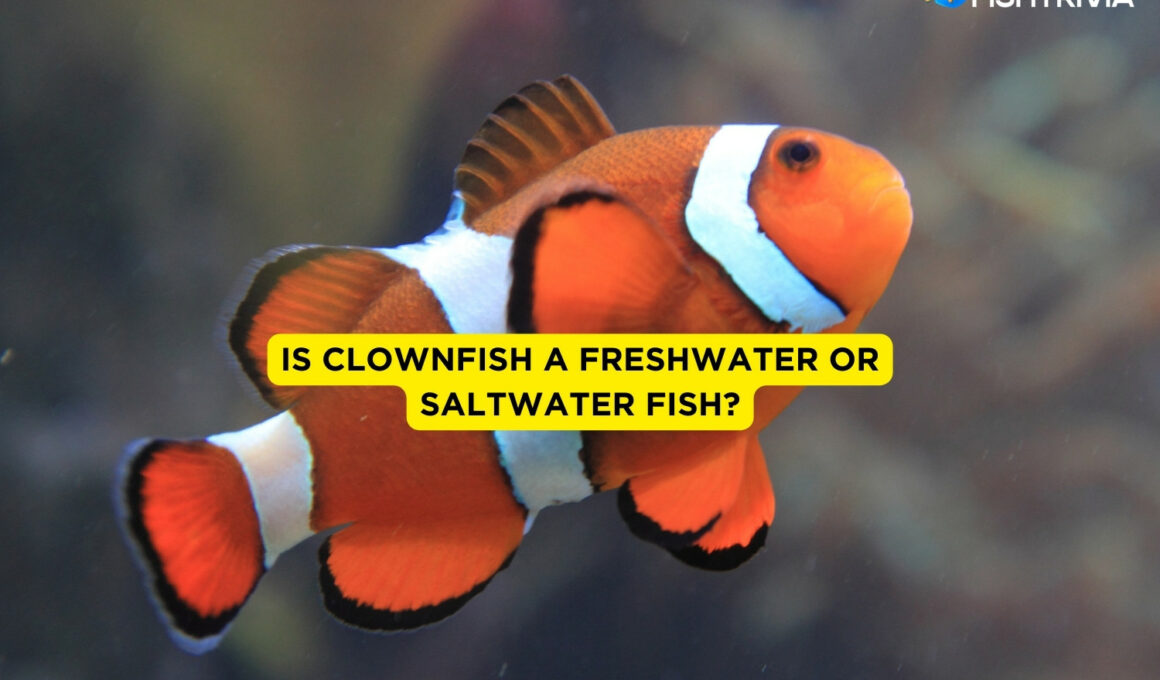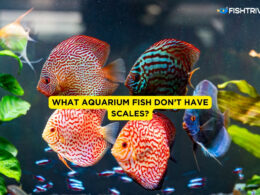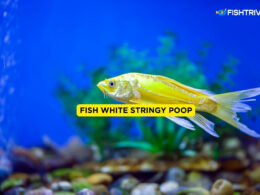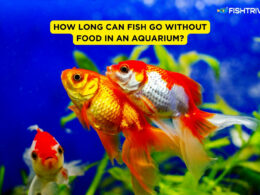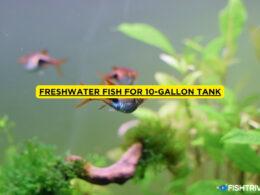In this article Show
Have you ever felt that you are making tea or coffee and accidentally you have put salt instead of sugar? And now, the drink is ruined.
Not knowing about the fish water type, you are about to put in your fish tank, is close to something like that. You have to be very certain about the fish you are about to put in your tank, whether is it freshwater or saltwater fish.
Clownfish is that adorable little orange and white fish and often have black linings that you are attracted to even though you don’t own an aquarium when you see them at the fish shop.
Here in this article, we are going to discuss the water type of Clownfish. After reading the whole article, you may not even believe how many clownfish there are.
Clown loach, clown knife cod, clown barb, clown rasbora, and clown pleco are some of the famous fishes with the term clown respectively. Many clowns are freshwater fish as a procedural word. Let’s get started with knowing everything about Clownfish.
Also worth reading;
- Freshwater Fish for 10-Gallon Tank: Which Are The Perfect?
- What Size is a 20-Gallon Fish Tank? (Dimensions)
- Aquarium Heater Size: What Size Heater Do You Need in a Fish Tank?
- How to Acclimate New Fish To Your Tank: 6 Easiest Drip Acclimation Steps
- Goldfish Tank Size: How Many Can You Keep in a Small Fish Tank
Is Clownfish A Freshwater Or Saltwater Fish?
Currently, there are 30 distinct clownfish species. The Ocellaris, the type of fish that Nemo was modeled after, is the most prevalent species. You will most likely find a couple of the other more common forms of clownfish in your local aquarium and pet shop.
As well as the Red Sea and even the Great Barrier Reef, Clown Fish emerged from the Pacific Seas and the Indian Ocean. Clownfish are commonly present in reefs and even lagoons that are not too deep in shallower depths around sheltered areas.
This means that clownfish are exclusively saltwater (marine) fish, which means they will not live in freshwater. But you’ll need to start a saltwater tank if you’re interested in buying Clown Fish.
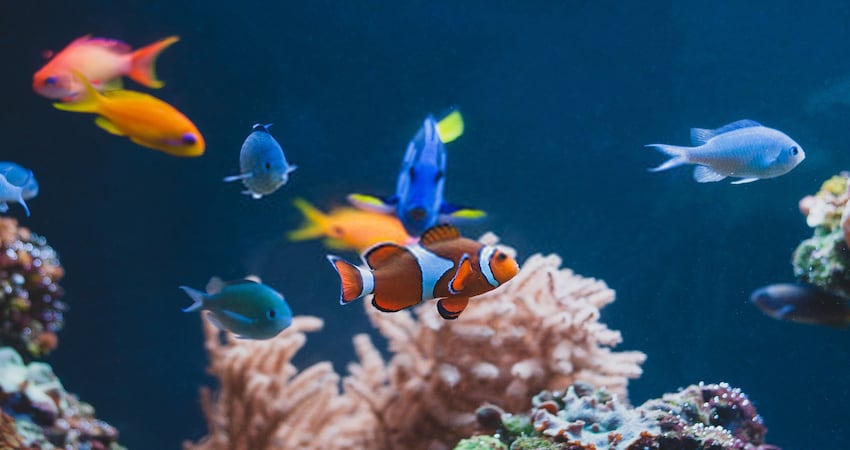
Clowning Behaviour of Clownfish
Clownfish are highly active and aggressive. The clownfish are thought of as “clowning around” since they are very active. They secure their territories and the anemone of the sea in which they live. Clownfish feed the anemone and algae leftovers from fish.
These fish have monogamous variations and are anemones territorial. During mating, men get more aggressive. Male comportments are often altered to draw women: biting, running, fining.
They also say a tiny position that has a bad current, whether they reside in the higher tank tiers. If they are added, they will leave this position close to Anemone as this is where they will find food.
Clownfish Diet
Clowns are all-fresh, meaning that they eat meat and vegetables. According to the National Aquarium, they normally consume algae, zooplankton, worms, and small crustaceans.
When they are tiny, the fish prefer to remain inside their anemone host. If they grow up, they will search for food, but according to the ADW, they will not go far beyond a few meters from the anemone.
To survive in their diet clownfish require some live fish food. A live feed is a perfect way to get to know the fresh, smaller surroundings of wild fish, including clownfish. Shrimps like Krill, Mysis, and Brine are the perfect live foods to feed your clownfish.
Although they swim in the tentacles of their host anemone for a large part of their lives, clownfish will occasionally feed.
They are plankton pickers so that particular zooplanktons or phytoplanktons swimming in the water column are visually searched for and consumed. You probably will consume algae from the top of the coral.
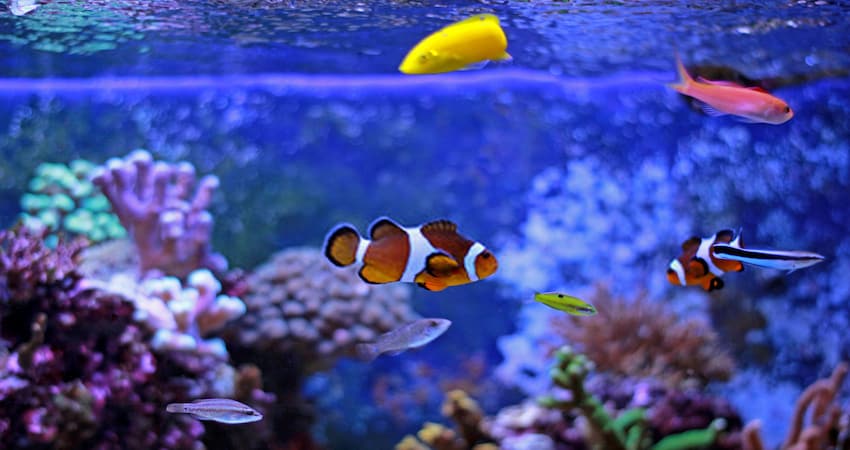
Clownfish Tank Preparations
From the above description, till now, you may have an idea of the behavior, water type, and every other important aspect. Now, to prepare the tank you have to be very careful.
All fish deserve a home of good water quality and a good diet regardless of their location. Both animals are, however, not made to live in one house. Before you bring fish home or even buy your aquarium, study what fish you want in your ideal habitat.
A tank with a capacity of at least 30 gallons is required for clownfish. The tank should have plenty of hiding spots to keep the fish safe.
Just like this, there are many more requirements to prepare a safe aquarium for Clownfish. Let’s know them;
1. Temperature
As previously described, clownfish need at least a 30-gallon capacity tank. The water must be between 74 and 78 Fahrenheit and must be 1.022 and 1.024 gravity. There should be mild water flow in the tank. It should send a little current, but for the clownfish, it should not dominate.
2. Habitat and Light
Clowns dwell on coral reefs or in shallow lagoons near Australia and Southeast Asia in warm areas of the Pacific and the Indian Oceans. They’re slow swimmers and so they stick to corals or rocks-covered anemones.
Therefore, loading the tank with some rocks is a smart idea. Don’t overfill as the clownfish float into the open ocean abyss. When at night you turn off the tank lights, the clownfish nap.
The fish nestles in an anemone, in rock crevices, and elsewhere. The fish might even be sitting at night on the b. The fish would not sleep if you leave the tank lighting at night. It will be anger and stressed ultimately. Extended light cycles can inevitably lead to fish death.
3. Salt Requirement
When calculating the right salt levels in the tank, you want the salt level between 34 and 36 PPT, and the basic gravity is best in the range between 1,021 and 1,026 for your Clownfish and virtually all the Saltwater Aquarium tenants.
PH should be between 8.0 and 8.4 inside your Clownfish saltwater aquarium. For your salt tank, the optimal water temperature should be between 73 Fahrenheit and 80 Fahrenheit which is around 22,8 Celcius to 27 Celcius.
Be sure that all equipment has performed properly for several days before adding some trout. You should not fluctuate the temperature and you should preserve the salinity. We encourage you to keep at least three days but preferably seven days, to make sure that the first fish is stable and healthy.
The size of the aquarium salt that best fits your tank size can be bought. To test the right parameters, you need a special salinity indicator.
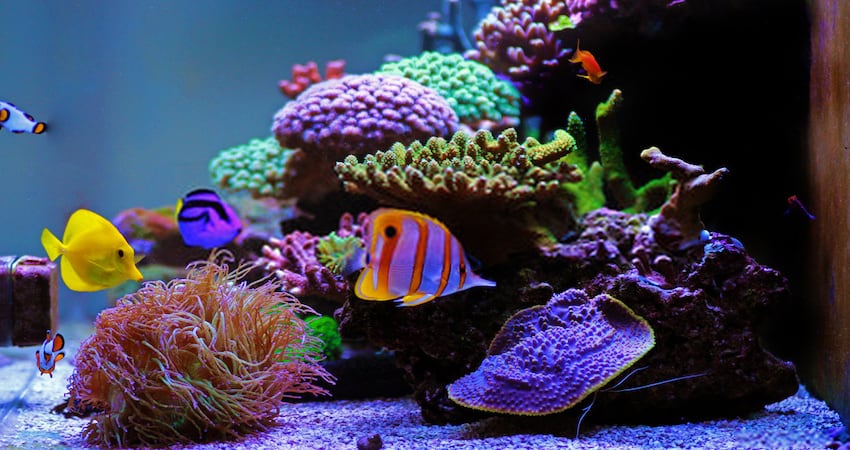
4. Water Flow Requirement
The structural identical or the same ecosystem is not produced for all fish. If clownfish have an inefficient water supply, they face undue stress or impaired water quality.
You can walk a fine line between abundance and too little flow, depending on the mix of organisms. To maintain good water quality, water flows must be directed through the entire tank region, but bear in mind that certain places will require less water flow.
Any decor you apply to your tank manipulates the flow of water in your aquarium. Smaller, nano-saltwater tanks are more prone to strong water flow since reverberations echo out through the tank’s edges.
5. Tank Mate Requirement
Clownfish fit well into an aquarium of “community” form. Clownfish are common for good cause, as sturdy as they are stunning! It contains tiny and peaceful species such as the Common Clownfish, and the large and unladen Maroon Clownfish.
Most clowns would not hurt other fish, but they are small enough that bigger tank mates might threaten them. Clownfish are also going to leave invertebrates behind, making them successful coral tank candidates.
Just one maroon clownfish can be aggressive and should be separated into a tank of tall, hardy fish of about the same size.
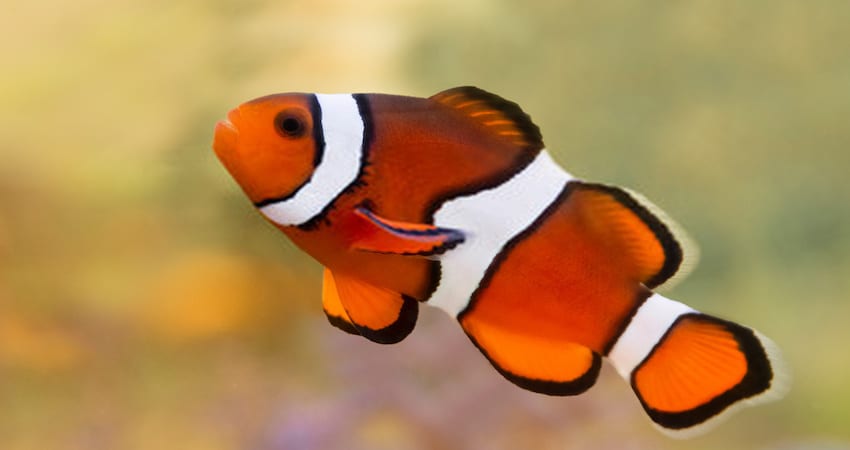
Freshwater Effect on Clown Fish
Clownfish is a purely aquatic saltwater fish that does not live in freshwater. Clownfish is a reef-associated fish that lives in the vicinity of the reefs. This means you will die in a couple of minutes if you put a clownfish in freshwater.
In freshwater, a saltwater fish contributes to osmosis. Osmotic pressure is the pressure exerted to counter the chemical migration of water across the semipermeable membrane. The osmotic pressure rises as water flows through a semipermeable membrane to a higher condensed solution.
Saltwater fish cannot live in freshwater because their bodies are heavily salt solution concentrated (too much for freshwater). The water will flood through your body until all of your cells build up so much water that you finally bloat and die.
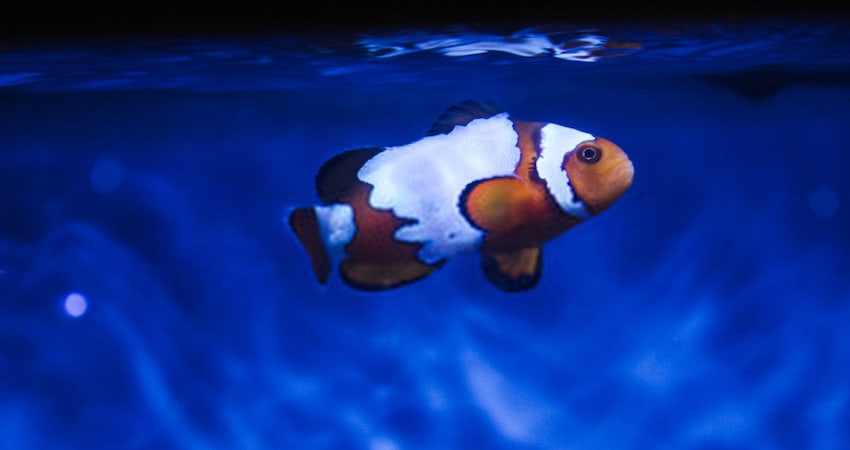
Clownfish Breeding in Fish Tank
Clownfish are outside breeders, which means the female fish lays the egg, and after laying the eggs the male fish fertilize them. To do this, you must have a pair of clownfish that are already tied, that is, partnered.
Whilst it is not difficult to breed these fish, they need some knowledge of the feeding of fish and the cycle of life, without mentioning the right supplies for the correct filtering of tanks and habitats.
You will want to check how you can start the saltwater aquarium, or how you can set up a marine reef aquarium, before diving in fish.
Many aquarium shops are offering clownfish-specific matted pairs. If your store has no stock, you should possibly order a pair just for yourself. Don’t be scared! Don’t be frightened!
The clowns spawned every 10-14 days while they were spawning daily. The eggs of clownfish are placed 8 to 10 days later. The larvae have always sprung up in the back-to-back nights which makes you crazy when you collect them from the breeding tank. A clownfish lays roughly every two weeks between 100 and 1500 eggs.
The eggs will be orange and stuck to rocks after they are laid. They will be cared for by the male clownfish which waves its fins around them to ventilate them. He may even choose those who died. In around 7 to 10 days, the eggs can hatch.
For the first week, you will have to feed the fry live rotors. Rotifers are plankton and are fed by several species. If you want to help your clownfish grow soon, you want to make them mash. You would then expect them to have enough calories to help them and not be likely to ingest the eggs.
Frequently Asked Questions
What is the specialty of Clownfish?
The clownfish has a special mucosal layer on the skin that protects it against poisoning the anemone. The clownfish gets defense from predators by staying in and around the anemone, and can even consume scrap from the anemone’s food.
Is clownfish a good choice for beginners?
Positive, clownfish are great beggar fish because they are easy to look after and hardy and do not need an enormous tank for happy survival. Since wild clownfish often remain in or close to anemones in the reef setting, very little room is needed for them.
Why are clownfish called clownfish?
Like a clown’s face paint, clownfish derive their name from the bold strokes on your body. Finding Nemo, a clownfish movie, has tripled domestic aquarium demand.
The number of eggs clownfish lays at once?
The eggs will be 3 to 5 millimeters long and will lay between 100 and 1000. The male crosses the nest and sperm is fertilized. The woman swims off then. The guy is mostly seated on the “egg sitting.”
Can you breed Clownfish in a tank?
Get an aquarium shop mated couple. The woman lays the eggs and then once placed, the male fertilizes them. To do this, you must have a pair of clownfish that are already tied, that is, partnered.
Conclusion
Clownfish are one of the most beautiful fish you can find. And yes, it is a saltwater fish and can not survive in freshwater. You should always keep your fish tank salinity in check with a salinity meter.
If you ever feel or see any change in your clownfish behavior, do not hesitate to check the salinity. Your fish would not survive without the preferred salinity.
We hope that we have managed to respond to your request. You will now have a successful clownfish aquarium in service with all the knowledge about clownfish.






